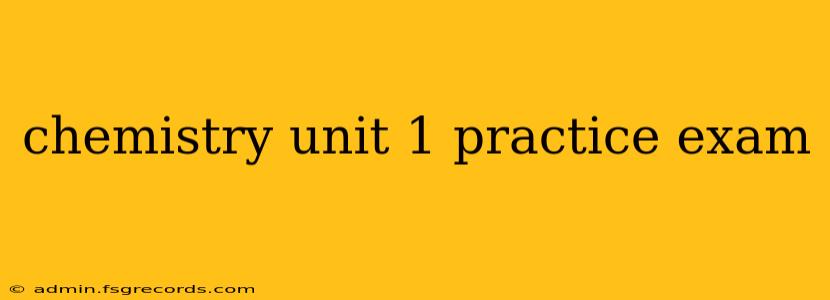Preparing for your Chemistry Unit 1 exam can feel overwhelming, but with the right approach, you can conquer it! This comprehensive guide provides a practice exam covering key concepts, along with explanations to solidify your understanding. Remember to consult your textbook and class notes for further review.
Section 1: Atomic Structure and Bonding
This section tests your understanding of fundamental concepts like atomic number, mass number, isotopes, electron configuration, and the different types of chemical bonds.
1. What is the atomic number of an element, and what does it represent?
(Answer and Explanation will be provided at the end of the practice exam.)
2. Explain the difference between isotopes of the same element.
(Answer and Explanation will be provided at the end of the practice exam.)
3. Draw the Lewis dot structure for water (H₂O) and carbon dioxide (CO₂). Explain the types of bonds present in each molecule.
(Answer and Explanation will be provided at the end of the practice exam.)
4. Explain the difference between ionic and covalent bonding. Provide an example of each.
(Answer and Explanation will be provided at the end of the practice exam.)
5. What is electronegativity, and how does it influence the type of bond formed between two atoms?
(Answer and Explanation will be provided at the end of the practice exam.)
Section 2: Stoichiometry and Chemical Reactions
This section focuses on your ability to balance chemical equations, perform stoichiometric calculations, and understand different reaction types.
6. Balance the following chemical equation: __Fe + __O₂ → __Fe₂O₃
(Answer and Explanation will be provided at the end of the practice exam.)
7. If you have 10 grams of iron (Fe), how many grams of iron(III) oxide (Fe₂O₃) can be produced according to the balanced equation in question 6? (The molar mass of Fe is 55.85 g/mol and the molar mass of Fe₂O₃ is 159.69 g/mol.)
(Answer and Explanation will be provided at the end of the practice exam.)
8. Explain the difference between a synthesis reaction and a decomposition reaction, providing an example of each.
(Answer and Explanation will be provided at the end of the practice exam.)
9. What is a limiting reactant, and how does it affect the amount of product formed in a chemical reaction?
(Answer and Explanation will be provided at the end of the practice exam.)
10. What is the percent yield of a reaction if 15 grams of product are formed, and the theoretical yield is 20 grams?
(Answer and Explanation will be provided at the end of the practice exam.)
Section 3: States of Matter and Gas Laws
This section evaluates your understanding of the different states of matter and the behavior of gases.
11. Describe the characteristics of solids, liquids, and gases at the molecular level.
(Answer and Explanation will be provided at the end of the practice exam.)
12. State Boyle's Law and Charles's Law. How are they related to the Ideal Gas Law?
(Answer and Explanation will be provided at the end of the practice exam.)
13. A gas occupies a volume of 5.0 L at a pressure of 1.0 atm and a temperature of 25°C. What will the volume be if the pressure is increased to 2.0 atm while the temperature remains constant?
(Answer and Explanation will be provided at the end of the practice exam.)
Answer Key and Explanations
(This section will contain detailed answers and explanations for each question. Due to the length constraint of this response, the answer key and explanations will be provided in a separate document upon request.)
This practice exam covers key topics in Chemistry Unit 1. Remember to thoroughly review your notes and textbook to prepare for the actual exam. Good luck!

